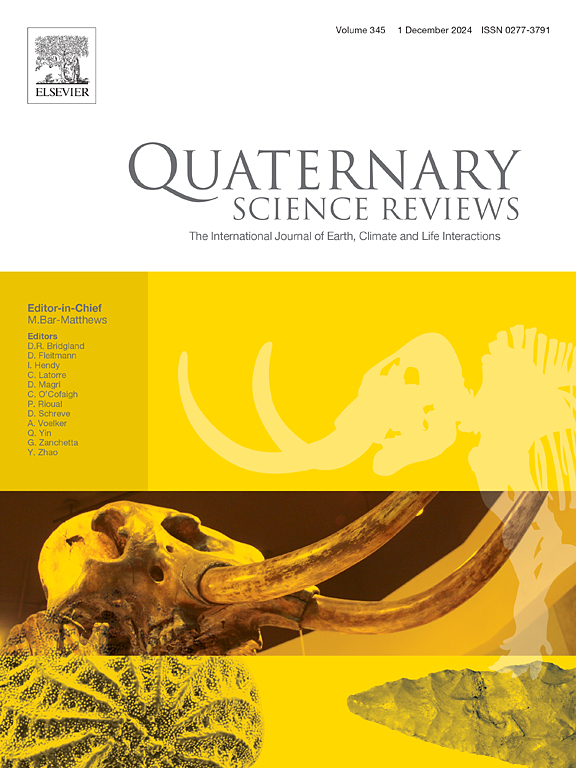印度尼西亚通流调节了澳大利亚夏季风穿过中布朗什事件
IF 3.2
1区 地球科学
Q1 GEOGRAPHY, PHYSICAL
引用次数: 0
摘要
早午餐活动(MBE;在~ 450 ka)代表了自海洋同位素阶段(MIS) 11以来的间冰期与变暖条件、更高的海平面和更小的冰量相关的全球气候变化,对理解全球气候动力学至关重要。迄今为止,印度尼西亚通流(ITF)和亚洲-澳大利亚季风动力学对MBE气候变化的敏感性尚未得到很好的记录。在这里,我们研究了国际海洋发现计划(IODP)站点U1483的粘土矿物,粒度和放射性成因同位素记录,这些站点来自澳大利亚西北部的东印度洋,在过去的795年中。这项研究为沉积物来源、ITF的长期变化及其对澳大利亚夏季风的影响以及海洋和大气系统在MBE上的相互作用提供了重要的见解。黏土矿物和Sr-Nd-Pb同位素表明U1483遗址沉积物主要来自澳大利亚西北部金伯利地区,少量来自ITF携带的帝汶地区。采用高岭石/蒙脱石比与平均粒度耦合来表示ITF和澳大利亚季风强度的变化。间冰期高岭石/蒙脱石的高值和平均粒度表明强烈的ITF,这可能有助于维持过去795 kyr高河流流量的湿润澳大利亚夏季风。相反,较低的数值意味着较弱的ITF,这可能是导致澳大利亚西北部在冰期干燥的主要放大因素之一。代用记录的光谱和小波分析显示,能量集中在100-kyr、41-kyr和23-kyr波段,表明与全球冰量和热带辐合带扩张/收缩相关的海平面变化对澳大利亚西北部古气候和粘土矿物沉积的共同影响。U1483站点黏土矿物、粒度及其相关代用记录的长期变化在MIS 12早期表现出显著的变化,与MBE相一致。我们将这种转变归因于沉积物源区的淹没和最近间冰期海平面上升导致的ITF增强。我们的发现为ITF和澳大利亚季风越来越多地受到全球海平面变化的影响以及MBE是影响季风和海洋系统的全球现象提供了证据线索。本文章由计算机程序翻译,如有差异,请以英文原文为准。
The Indonesian Throughflow regulated Australian summer monsoon across the Mid-Brunhes Event
The Mid-Brunhes Event (MBE; at ∼450 ka) represents a global climate shift associated with warmer conditions, higher sea levels and smaller ice volume during the interglacials since Marine Isotope Stage (MIS) 11 and is of critical importance for comprehending global climate dynamics. To date, the sensitivity of the Indonesian Throughflow (ITF) and the Asian-Australian monsoon dynamics to changing MBE climate have not been well documented. Here, we investigated clay mineral, grain size and radiogenic isotopic records of the International Ocean Discovery Program (IODP) Site U1483 from the eastern Indian Ocean off northwest Australia over the last 795 kyr. This study provides crucial insights into the sediment source, long-term variability of the ITF and its influence on the Australian summer monsoon and the oceanic and atmospheric systems interplay across the MBE. Clay minerals and Sr-Nd-Pb isotopes suggest that the sediments of Site U1483 are primarily from the Kimberley region of northwest Australia with minor contributions from the Timor region carried by the ITF. Kaolinite/smectite ratio coupled with mean grain size were adopted to indicate variability in the intensity of the ITF and Australian monsoon. High values of kaolinite/smectite and mean grain size during interglacials indicate a strong ITF, which may have contributed to maintaining the humid Australian summer monsoon with high river discharge over the last 795 kyr. In contrast, low values imply a weak ITF, which might have been one of the major amplifying factors resulting in dry conditions over northwest Australia during glacials. Spectral and wavelet analyses of the proxy records display the concentration of power on 100-kyr, 41-kyr and 23-kyr bands, implying jointly effects of sea level variations associated with the global ice volume and expansion/contraction of the Intertropical Convergence Zone on the paleoclimate and clay minerals sedimentation along northwest Australia. The long-term variations of clay minerals, grain size and their relevant proxy records from Site U1483 display a remarkable shift at an earlier stage of MIS 12, coinciding with the MBE. We attribute this shift to the submergence of sediment source areas and enhanced ITF due to sea-level rise in recent interglacials. Our findings provide insights into the line of evidence that the ITF and Australian monsoon became increasingly forced by the global sea level change and the MBE was a global phenomenon influencing both the monsoonal and oceanic systems.
求助全文
通过发布文献求助,成功后即可免费获取论文全文。
去求助
来源期刊

Quaternary Science Reviews
地学-地球科学综合
CiteScore
7.50
自引率
15.00%
发文量
388
审稿时长
3 months
期刊介绍:
Quaternary Science Reviews caters for all aspects of Quaternary science, and includes, for example, geology, geomorphology, geography, archaeology, soil science, palaeobotany, palaeontology, palaeoclimatology and the full range of applicable dating methods. The dividing line between what constitutes the review paper and one which contains new original data is not easy to establish, so QSR also publishes papers with new data especially if these perform a review function. All the Quaternary sciences are changing rapidly and subject to re-evaluation as the pace of discovery quickens; thus the diverse but comprehensive role of Quaternary Science Reviews keeps readers abreast of the wider issues relating to new developments in the field.
 求助内容:
求助内容: 应助结果提醒方式:
应助结果提醒方式:


